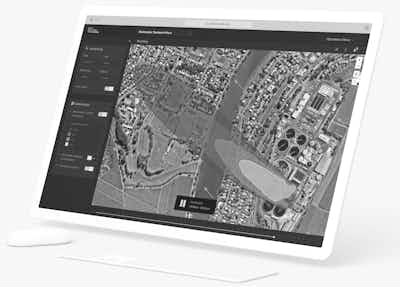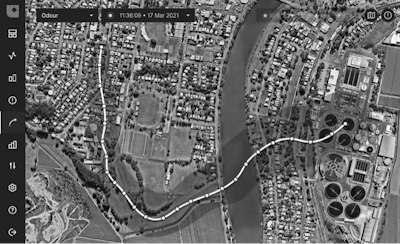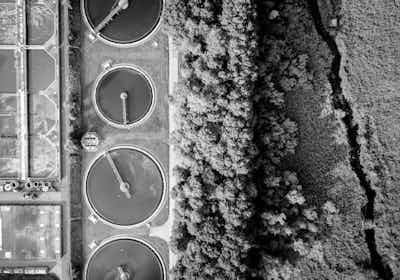Growing communities are moving closer to wastewater treatment plants. Each year, around 359 billion cubic metres of wastewater is produced around the world. That’s the equivalent of 144 million Olympic-sized swimming pools.
That amount of wastewater is hard to imagine – and it’s only going to increase as our global population soars in the years ahead. Worldwide, there are currently 7.6 billion people. This figure is set to skyrocket to 9.8 billion by 2050.
As our population grows, the pressure on urban wastewater treatment plants to process significantly more wastewater is anticipated to become even stronger. There will be additional pressure on operators to avoid impacting growing communities with odour and air quality emissions.
Buffer distances around plants were once an effective strategy for odour control, but growing populations are now moving closer to boundaries. Changing weather conditions and odour abatement strategies now pose more a challenge for plant operators than ever before.

Growing communities are moving closer to wastewater treatment plants.
Wastewater management, odour modelling and sensitive receptors in the community
While unpleasant odours may start out as a nuisance, they can quickly evolve and eventually reach harmful levels. People have different levels of sensitivity to odour, and even in low concentrations some individuals may experience headaches, eye, nose and throat irritation, nausea and more.
The delicate balance of minimising odour emissions risk, co-existing with communities and satisfying compliance with local regulators starts with implementing the correct mitigation strategies. But complex issues require complex solutions, and odour management certainly isn’t straightforward.
This is where proactive odour emissions modelling technology has emerged as a powerful operational tool. Insights from emissions modelling can provide a practical, effective and reliable option for plants looking to better control the risks and future proof operations while also understanding the root causes of odour issues.
Analysing past and future with odour emissions modelling for wastewater management
For many operators at wastewater treatment plants diagnosing the source of odour complaints directed at their site is difficult. Operational personnel tasked with investigating the cause of disruptive odour emissions and finding a resolution will be familiar with how difficult this can be, even when complaints aren’t being submitted in high volumes. Rapid changes in weather and historical reporting data with little context make it challenging to pinpoint a culprit.
Unfortunately, most systems for odour management focus on the collection, storage and only sometimes, the display of information. Although useful for reporting on issues that have happened in the past, analysis of data is time consuming and difficult for non-subject matter experts. At the end of a lengthy investigation, results are inconclusive, and the opportunities for operational improvement have passed.
Operational personnel at today’s wastewater treatment plants require a quick and accurate understanding of how changes in weather are impacting their operations, or where the source of an odour issue may be coming from.
Insights from odour modelling have made it possible for plant operators to enjoy all the benefits of complex software – without needing to be an expert in the area.

Envirosuite software can model odour and air quality emissions with local weather conditions for up to 72 hours in advance.
Can odour modelling provide operational benefits for wastewater management?
Real-time data and visualisation, weather forecasts, reverse trajectory modelling and ground level odour measurements are all a part of the equation. Together, these capabilities can help operators achieve situational awareness of their plants.
Arguably one of the biggest benefits of having this at your fingertips is that you can receive early warnings, predict when odour problems may arise, and take action ahead of time. For instance, when you know upcoming weather conditions present a minimal risk to odour impact, it’s possible to schedule maintenance activities during this time, rather than taking a stab in the dark.

Envirosuite software displays weather and odour risk for wastewater operators to plan ahead for work shifts.
If the community does direct any odour complaints at your facility, usual investigation times can be drastically reduced by running reverse trajectory modelling. Operational personnel can work backwards from the location of the complaint to the source of the odour problem.
Operators can determine if it was their facility that caused the issue, or if it was something else. Resources can also be allocated correctly rather than wasting time and money on efforts that are misdirected and ineffective.
From avoiding odour issues getting out of hand, to keeping community annoyance to a minimum and helping your facility uphold a positive reputation in surrounding areas, there is a significant amount to gain from targeted action and faster resolutions.

Envirosuite software allows operators to run reverse trajectory models to determine the source of odour complaints directed at their facility.
Envirosuite’s practical solution for odour management
Odour management doesn’t need to cause headaches for your wastewater plant.
With Envirosuite’s odour management software, facilities can collect and interpret complex data, address operational challenges and build trust with stakeholders.
Odour management systems give you the information you need to act on problematic sources of odour emissions by pinpointing the source of the issue so you can:
Make confident decisions that optimise operational outcomes.
Proactively minimise environmental risks and maintain environmental compliance.
Improve transparency with local communities and government.
Reduce response times with targeted action.
Avoid chronic odour problems.
Built on 30+ years of expertise and applied odour management for wastewater treatment plants, our software is trusted on a global scale.
Contact us today to find out more about proactive odour modelling
Envirosuite’s user-friendly odour modelling software can be implemented quickly and effectively by wastewater treatment plants. Contact us today to talk with our team about your odour management requirements.
